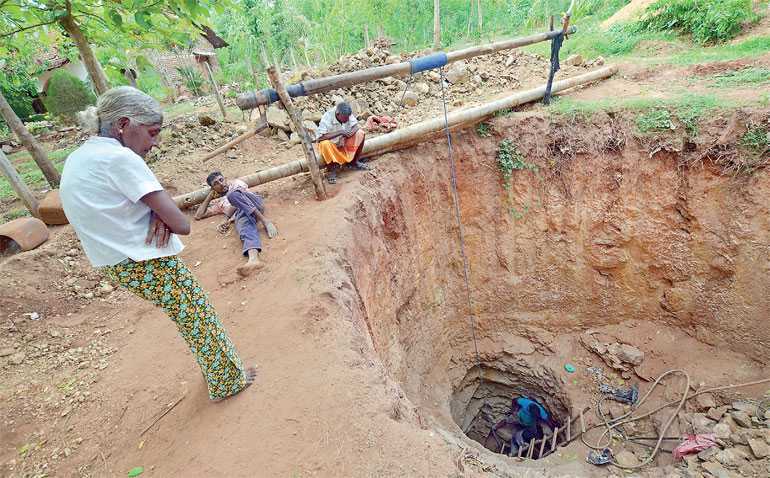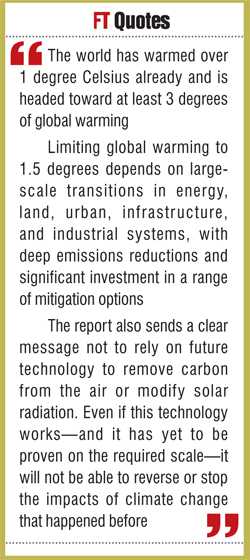Saturday Nov 29, 2025
Saturday Nov 29, 2025
Wednesday, 10 October 2018 00:00 - - {{hitsCtrl.values.hits}}

The IPCC has released its most comprehensive and critical report on climate change for years to come. Its findings show the profound impacts on human life and the decisive actions necessary to keep global temperature rise below 2 or 1.5 degrees Celsius, as well as the huge differences between these two scenarios. If the world as we know it is to survive climate change, this report is required reading for everyone
Climate change is real, and its impacts cannot be overstated. Climate change is happening now and happening everywhere, from developing to developed nations, from North to South and East to West.

The 2015 Paris Agreement has set the governments of the world on a path of mitigation and adaptation, and the Conference of the Parties (COP24) in December 2018 will assess their collective commitments (the Nationally Determined Contributions) and efforts.
The world has warmed over 1 degree Celsius already and is headed toward at least 3 degrees of global warming. Time is running out fast: but at this juncture, the world still has the means and enough years left to change its path and choose one of two possible futures: one with 1.5 degrees or one with 2 or more degrees of warming.
A report of critical importance
On 8 October, the Intergovernmental Panel on Climate Change (IPCC) published the final version of its ‘Special Report on 1.5 Degrees’. Scientists and government delegates from around the world met in Incheon, South Korea the previous week, where they went word by word through the 15-page summary and agreed on a final version.
Ninety-one authors and review editors from 40 countries, nominated by governments and institutions, have compiled this report over more than two years. They have evaluated an extremely wide range of literature and cite over 6,000 references in the report. Their findings rest on the broadest possible consensus and are beyond doubt.
Global warming : 1.5 versus 2 degrees
The key goal of the Paris Agreement is to keep the rise of global mean temperatures below 2 and ideally below 1.5 degrees Celsius above pre-industrial levels. Since the 1850s, the world has already passed 1 degree of global warming, and things are about to get much worse. All current commitments made under the Paris Agreement will together still lead to a global warming of 3 or more degrees by the end of this century.
The IPCC’s report shows that there are grave impacts at 1.5 degrees of global warming and already at the present 1 degree: anything more than a 1.5-degree rise will lead to catastrophic climate change around the globe. This poses an existential threat to billions of people, many of them in the poorest regions of the world: from island nations swallowed by the sea to flooded coastal megacities, extreme storms, mass displacement, and droughts that will cripple agricultural production and turn vast lands into desert.
The disparities between a 1.5- and a 2-degree scenario are immense. With 1.5 degrees, several hundred million fewer people will be exposed to climate-related risks and poverty, suffer from heat extremes or water scarcity, and lose their livelihoods. The risk of heavy precipitation decreases significantly, and the mean sea level will rise by 0.1 m less until 2100, a difference of life and death for many small island states.
If global warming reaches two or more degrees, coral reefs will be completely destroyed by 2100. The arctic will experience ice-free summers at least once a decade (ten times more often than at 1.5 degrees), diseases like malaria and dengue will spread far beyond their current range, and deaths related to heat and ozone will increase greatly. Especially for a tropical island country like Sri Lanka, the impacts cannot be overstated: agriculture, coastal resources, heat extremes, droughts, storms, precipitation patterns and loss of biodiversity will present almost insurmountable challenges.
Limiting global warming to 1.5 degrees with no overshoot also keeps many adaptation options more viable. Vulnerable populations will have time to adapt to the changing climate, and less extreme circumstances to adapt to.
Two pathways into the future
According to the IPCC report, achieving the target of 1.5 degrees requires drastic steps. Human-induced CO2 emissions need to reduce by 45% by 2030 and reach net zero by 2050 (for a 2-degree target, the numbers would be 20% by 2030 and net zero by 2075). Without decisive action, the world is likely to reach 1.5 degrees between 2030 and 2052, and warming will only accelerate from there.
Limiting global warming to 1.5 degrees depends on large-scale transitions in energy, land, urban, infrastructure, and industrial systems, with deep emissions reductions and significant investment in a range of mitigation options. Cuts to CO2 emissions, a rapid move to renewable energy, changes in lifestyle and consumption, and efforts to remove greenhouse gasses from the atmosphere are among the main actions recommended by the report.
Investments of around $ 2.4 trillion per year (2.5% of global GDP) in the energy system will be required: and while this sounds extreme, the costs of unchecked global warming are likely to be higher by magnitudes. There are also a number of synergies and cross-benefits that might offset these investments and even turn them into an economic net gain.
The necessary resources, technologies, and knowledge are ready and proven, but they need to be implemented across the board. Keeping global temperature rise below 1.5 degrees is still possible, and given the findings on the 2-degree scenario and the enormous differences to the 1.5-degree one, it has never been more essential to try everything in our power to do so.
The report also sends a clear message not to rely on future technology to remove carbon from the air or modify solar radiation. Even if this technology works—and it has yet to be proven on the required scale—it will not be able to reverse or stop the impacts of climate change that happened before. If global warming exceeds 1.5 degrees, some ecosystems will be gone forever, and the catastrophic impacts of climate change will persist for decades and centuries to come, even if emission levels and temperatures are brought down again.
It is imperative not to let global warming overshoot the 1.5 threshold if the adverse effects of climate change are to be minimised to save countless lives, livelihoods, ecosystems, and trillions of dollars.
Outlook
Whether global warming reaches 1.5, 2, or 3.5 degrees, the world will change dramatically over the next decades. There cannot be a neutral stance on climate change, only different courses of action.
If the signatories to the Paris Agreement want to keep true to their ambitions and achieve their stated goals, they will need to commit to urgent and far-reaching actions at the December conference in Katowice, Poland. Climate change mitigation is now the highest priority for the world. It will require political, economic, technological, social, and personal efforts as well as international cooperation on all levels to succeed.
The IPCC report is the most comprehensive and critical report on climate change for years to come. Its findings show the profound impacts on human life and the decisive actions necessary to keep global temperature rise below 2 or 1.5 degrees Celsius, as well as the huge differences between these two scenarios. If the world as we know it is to survive climate change, this report is required reading for everyone.
(The writer currently lives in Colombo as a freelance writer and researcher on climate change and education. He focuses on ecosystem-based adaptation and sustainable urban development as well as on autism spectrum disorder in the field of education. Besides articles and research, he has published numerous works of fiction in German and English.)